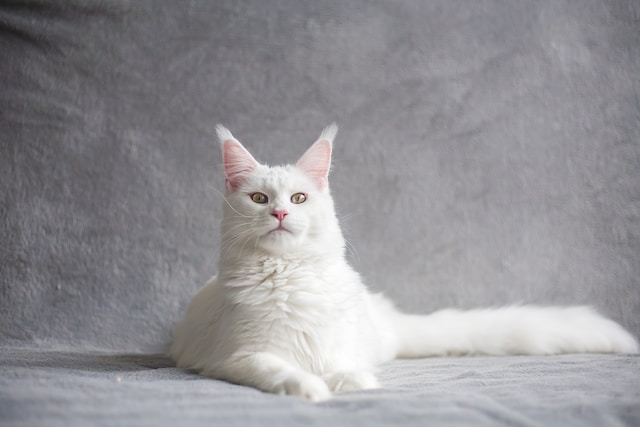In order to maintain the health and happiness of long-haired cats, it is imperative that they receive adequate love and attention. It should be noted that their coats necessitate a greater degree of grooming in comparison to short-haired cat breeds.
Maine Coon Cat Daily Grooming
Daily grooming of a feline is of utmost importance for its hygiene as well as for monitoring its physical well-being. Despite popular belief, cats do not groom themselves excessively, and their natural behavior of licking themselves after certain activities does not suffice as an alternative to daily grooming.
While it is true that cats are capable of self-grooming by licking themselves, it is important to note that they are unable to maintain the desired level of cleanliness on their own. Regular grooming by humans is essential in order to remove dirt and tangles from their fur. Additionally, it is crucial to regularly clip their nails.
The frequency of brushing a cat’s fur is contingent upon its breed. Short-haired felines necessitate brushing two to three times per week, while long-haired cats should be groomed at a minimum of once daily to prevent matting and tangling. It is advised to groom them after waking up from slumber.
The undercoat of felines can ensnare foreign substances such as dirt, debris, and insects. This layer of fur aids in regulating body temperature during both winter and summer seasons. Long-haired felines are more prone to hairball formation due to the difficulty of digesting their dense coats. Although, not all long-haired breeds are vulnerable to hairballs, especially those with fewer undercoats and denser top coats. However, if your feline exhibits symptoms of vomiting with bile and hair, it is imperative to seek veterinary care for a thorough evaluation.
Prior to discussing the essential grooming tools required for Maine Coon Cats, it is imperative to review the prevalent medical conditions that afflict these felines.
– Hyperthyroidism is a medical condition characterized by overactivity of the thyroid gland, resulting in symptoms like increased appetite and weight loss. Treatment options include oral medication and iodine supplementation.
– If a feline exhibits symptoms such as recurring redness, itching, or open wounds on the skin, it may be indicative of Canine Atopy or Allergic Skin Disease. It is recommended to consult with a veterinary professional to conduct a skin test and identify potential allergens to treat the condition effectively.
– Ear mites are a prevalent condition among felines and can be managed through appropriate medication prescribed by a licensed veterinarian. These minuscule parasites inhabit the ear canal and may induce intense pruritus, discomfort, and potential infection.
– Felines commonly experience dental afflictions, with halitosis being an initial indicator. A thorough examination of your cat’s teeth can be conducted by visually inspecting or palpating them. Should any irregularities be detected, prompt veterinary intervention is advised.
The most common grooming tools
Herein are listed some of the most frequently utilized grooming implements:
1. Waterless Cat Shampoo and Conditioner: It is recommended to bathe and cleanse your feline companion every two weeks using waterless shampoo and conditioner specifically formulated for cats. The gentle and safe formula is suitable for cats with even the most sensitive skin.
2. Shedding Comb: This comb can be utilized on a daily basis to eradicate excess hair from your feline’s coat. Additionally, it promotes the secretion of natural oils in the skin, thus maintaining its fur’s luster and vitality.
3. Furminator deShedding Tool: Cats possessing long coats require consistent grooming due to the inability of a comb to fully eradicate their fur. Furthermore, this grooming technique serves to reduce the production of shed hair for future shedding.
5. Pin and Bristle Brush: It is recommended to utilize these brushes on a weekly basis or as needed in cases of excessive dirt accumulation on your cat’s coat. The pin brush’s design allows for effective removal of dirt and dander from the topcoat. Conversely, the bristle brush is best suited for daily grooming, as it facilitates the distribution of natural oils throughout your cat’s fur.
6. Rubber Curry Comb: This particular comb is equipped with rubber teeth, as indicated by its name, which enables the user to delicately massage their pet while simultaneously eliminating any ingrained debris or fur from the animal’s coat.
7. Soft Slicker Brush: Consistent use of this grooming tool aids in maintaining the luster and wellness of your feline’s coat by evenly dispersing the innate oils and promoting circulation to the dermis.
8. Double Sided Comb: The double-sided comb in question is highly recommended for thick coats due to the proximity of its teeth, which effectively remove even the most minuscule tangles and dirt.
9. Slicker Brush: This brush is specifically designed for short-haired cats, as its closely-set teeth enable easy removal of mats and tangles when used after bathing or when the cat’s coat is wet.
10. Grooming Mitt: The process of removing loose hair from a cat’s coat can be a time-intensive task, requiring multiple passes over each section. However, with the use of this specialized mitt, hair can be swiftly and effectively eliminated from your feline’s body, freeing up more time for quality playtime with your beloved pet.
